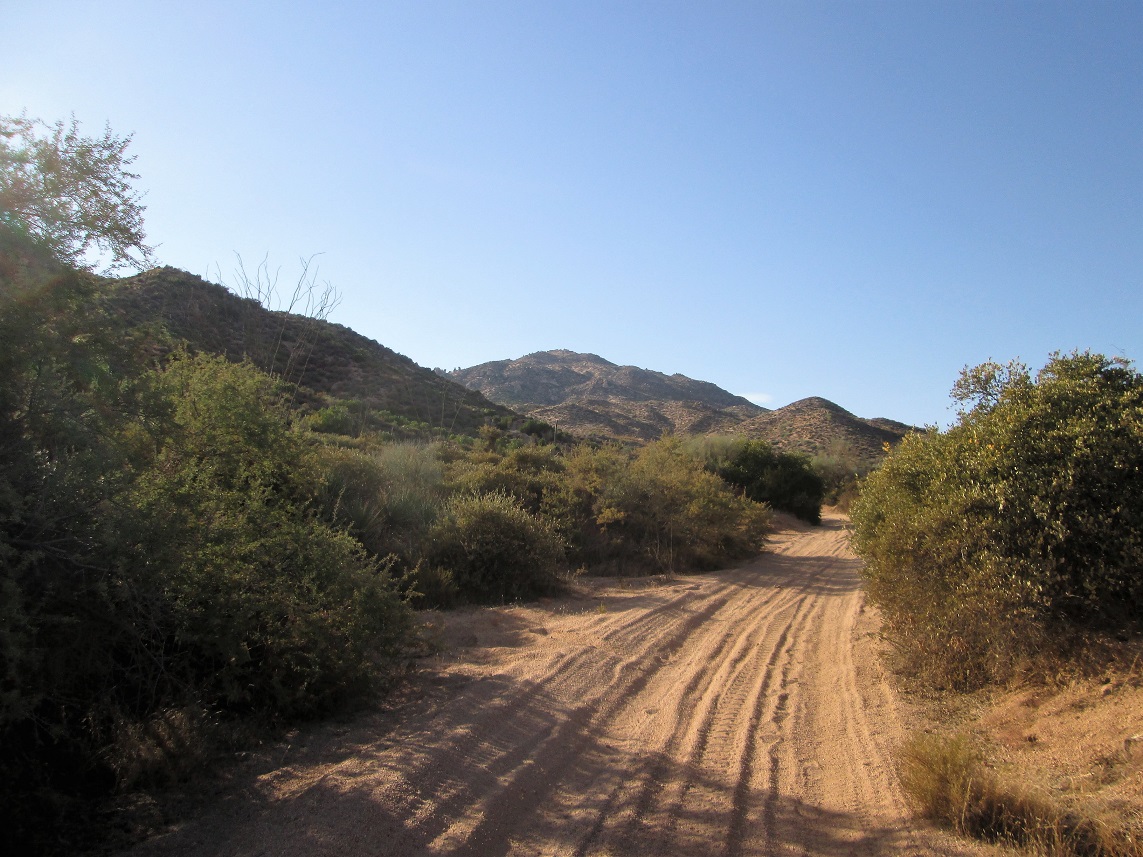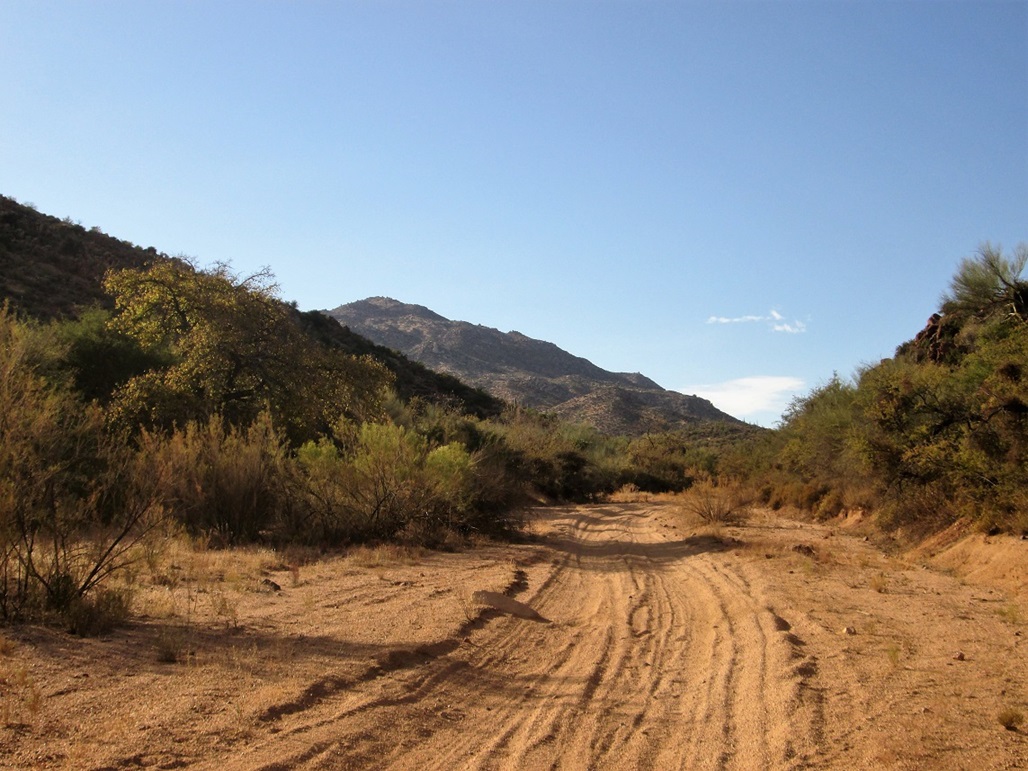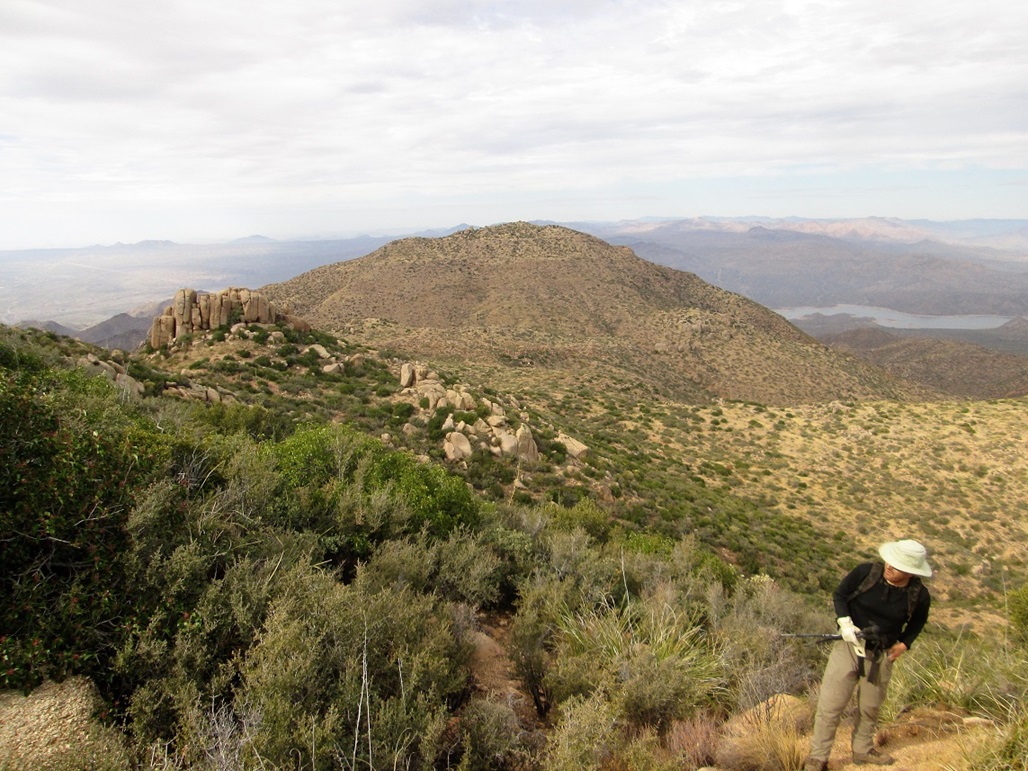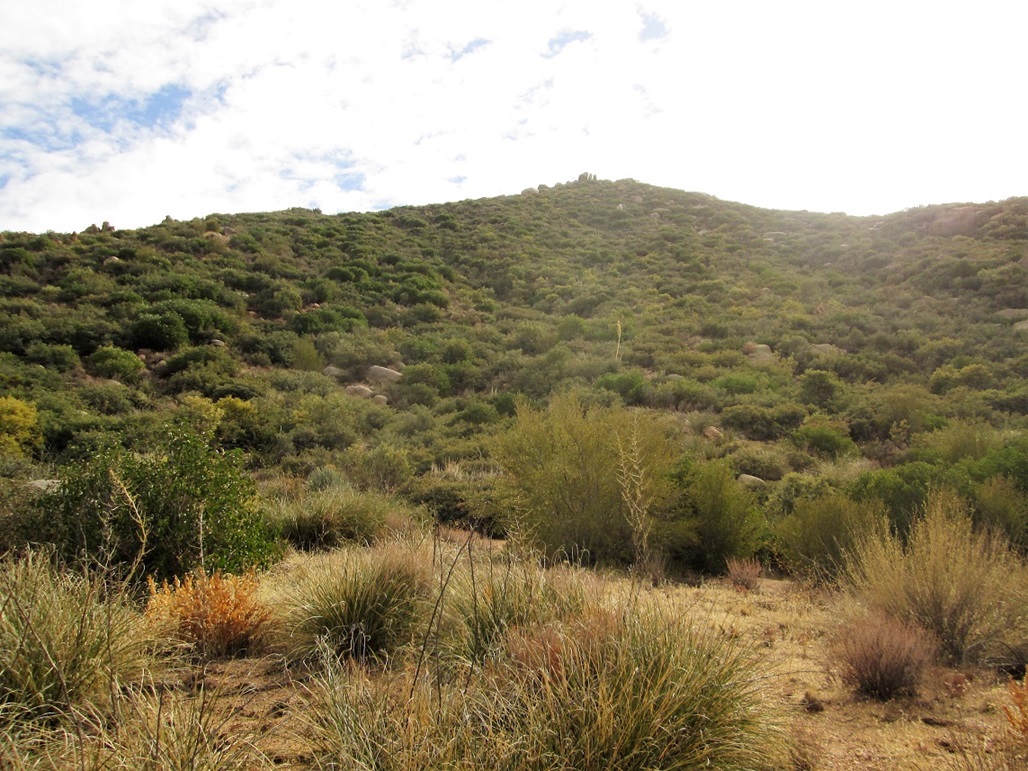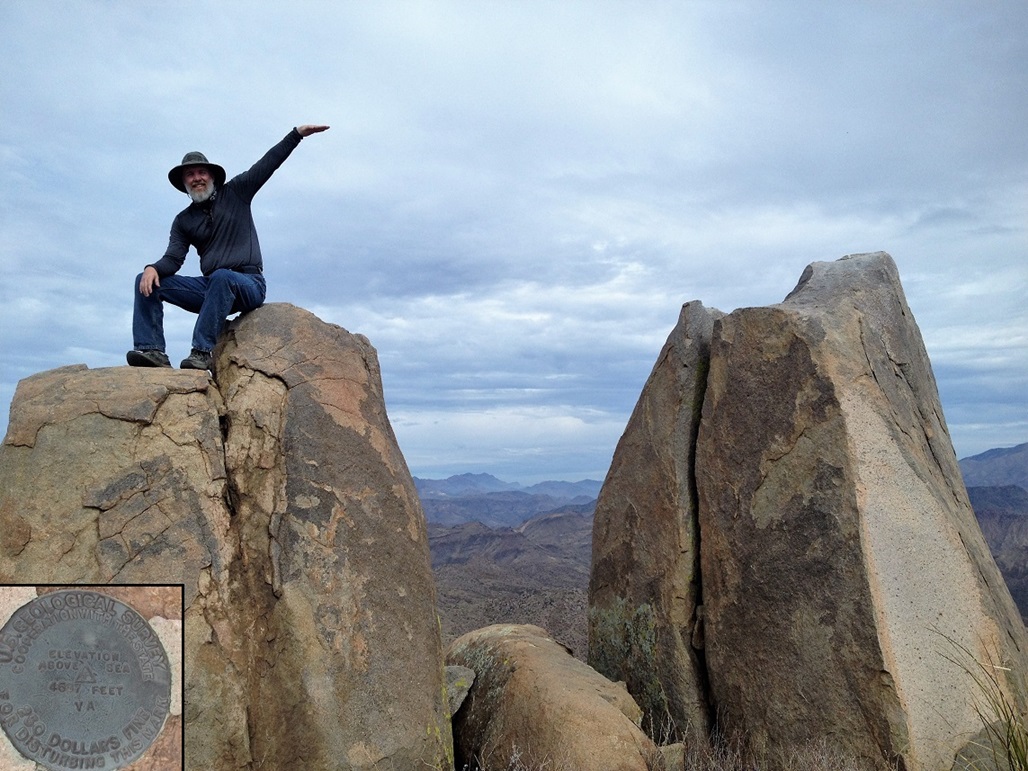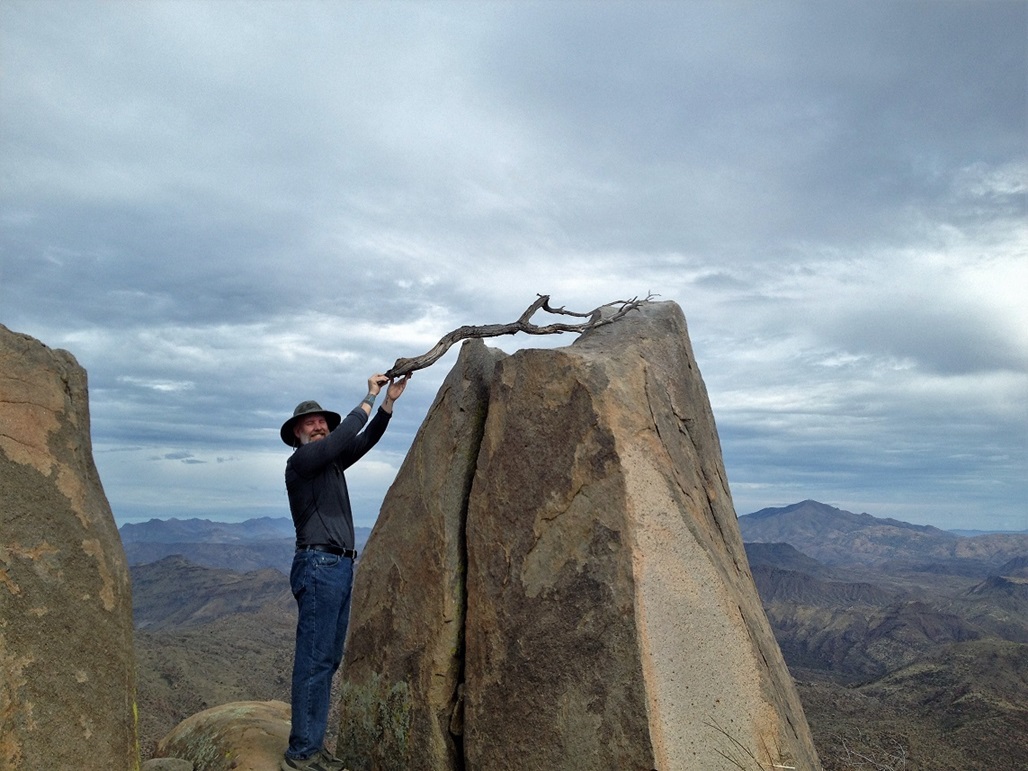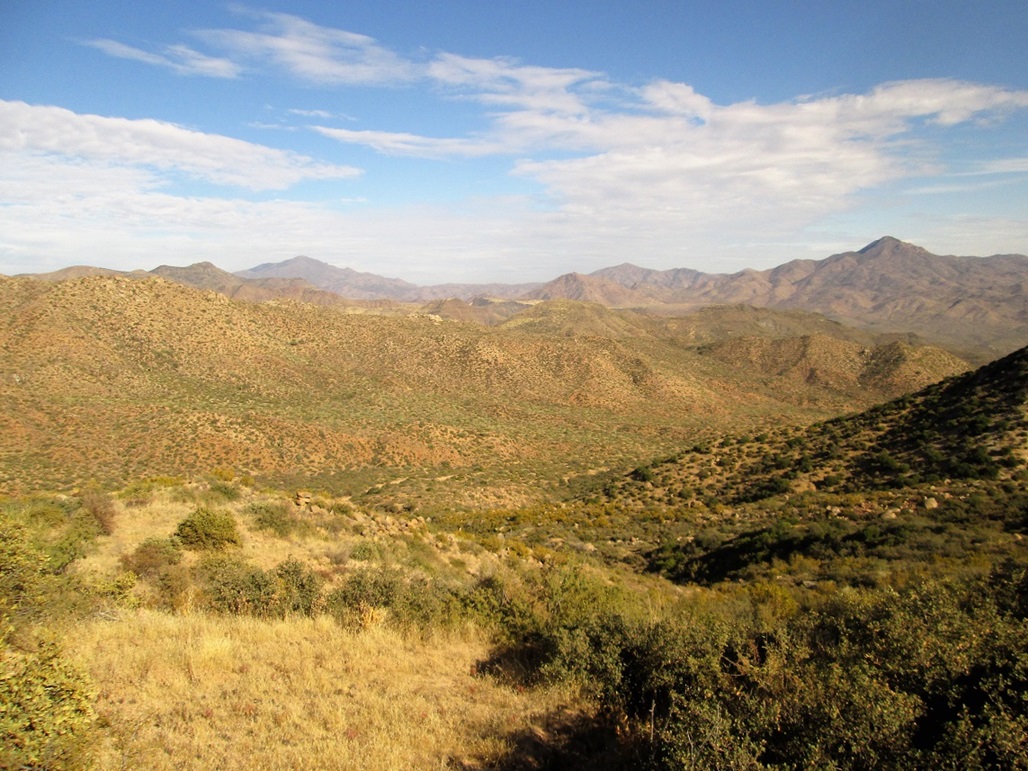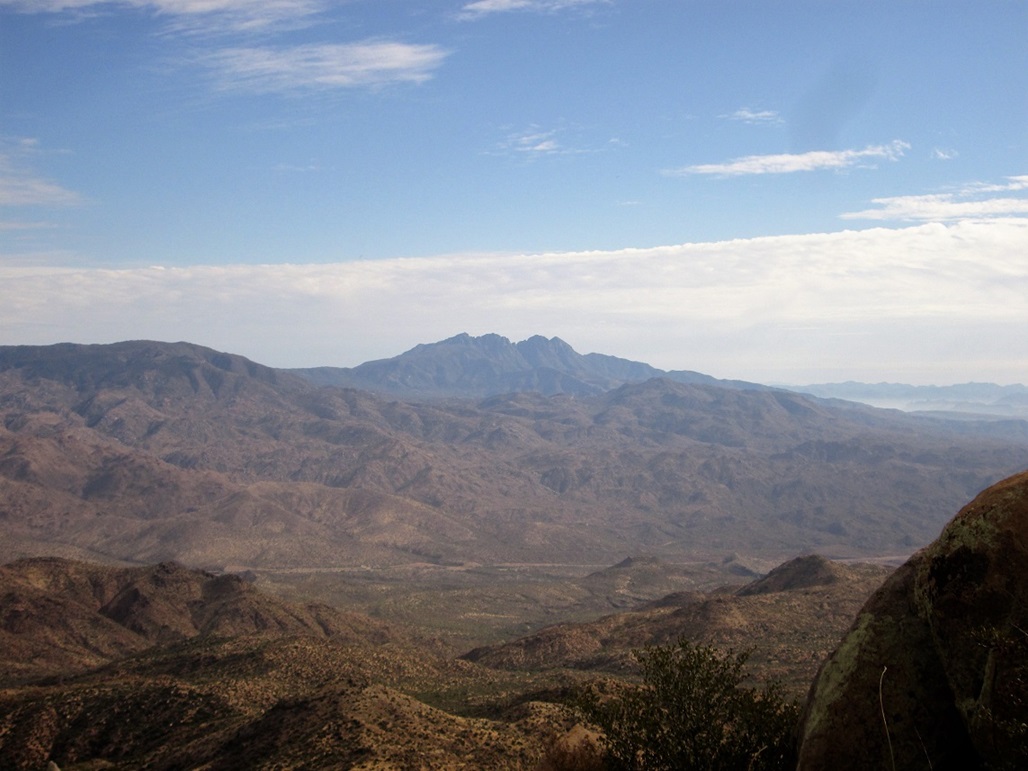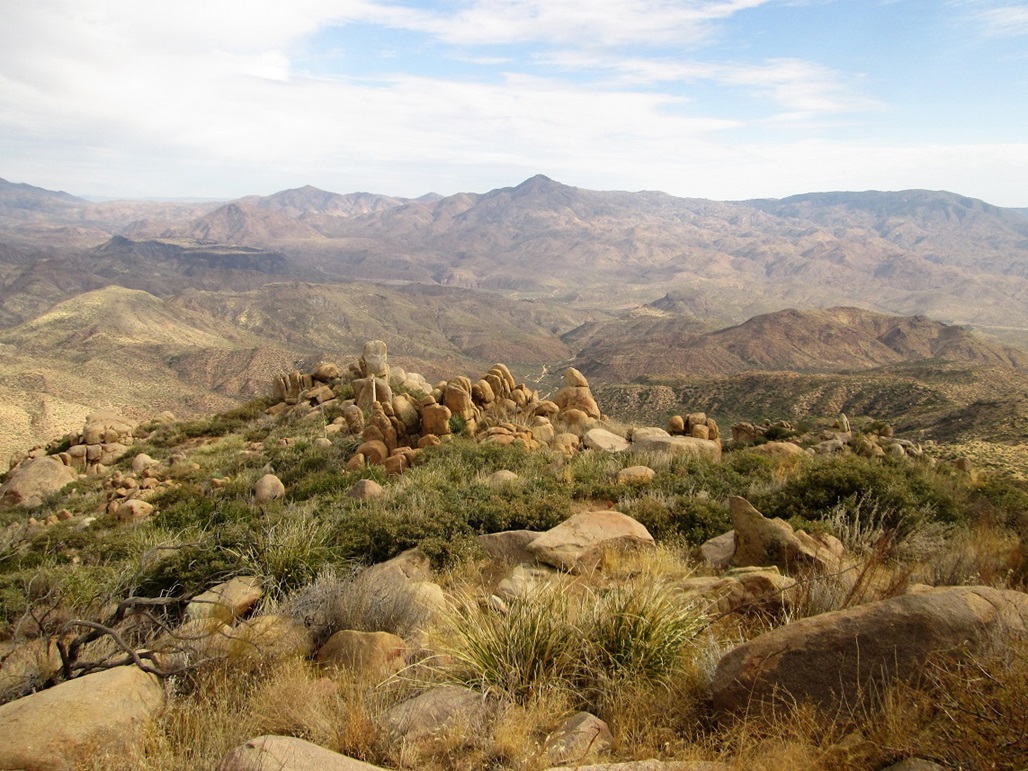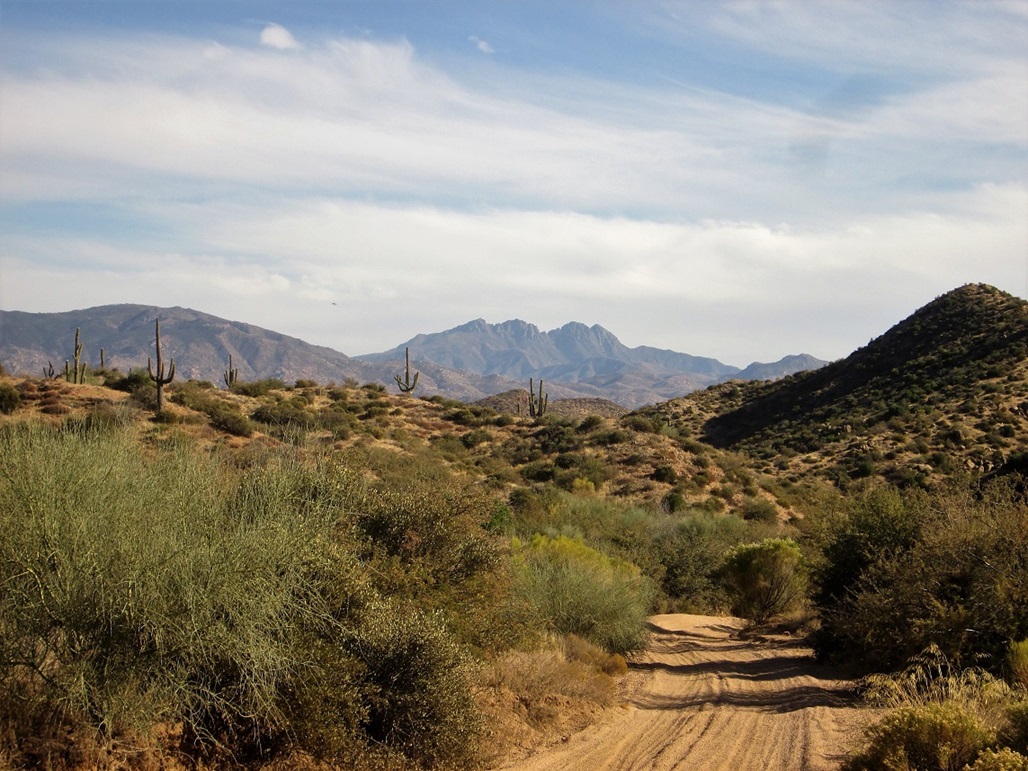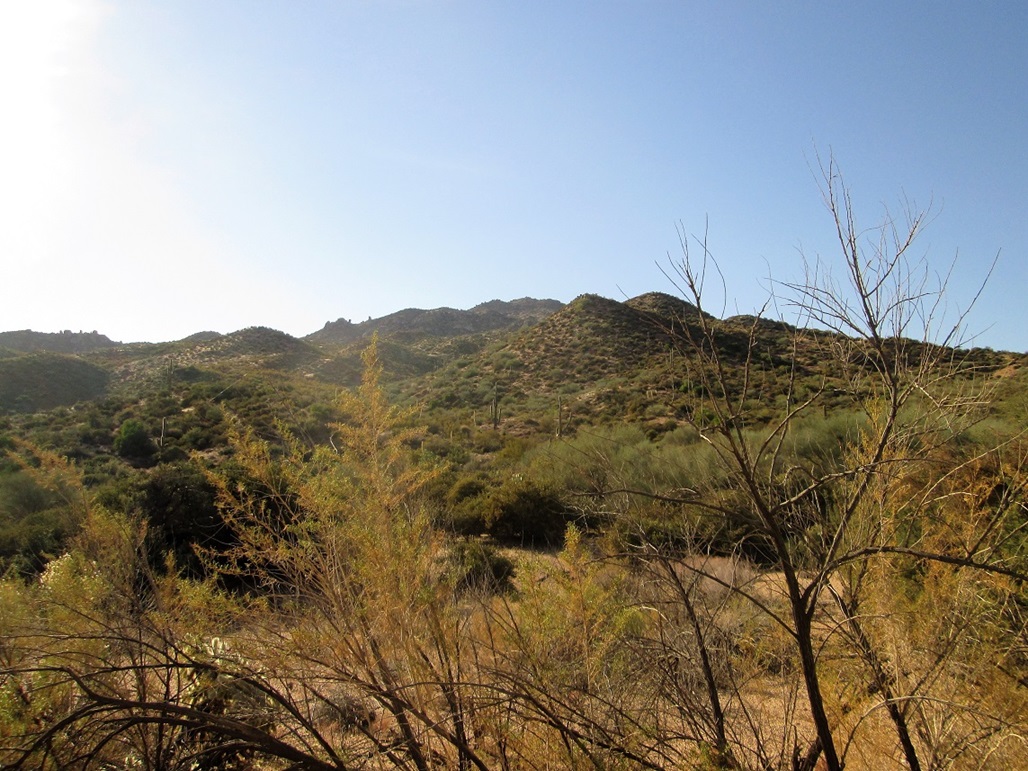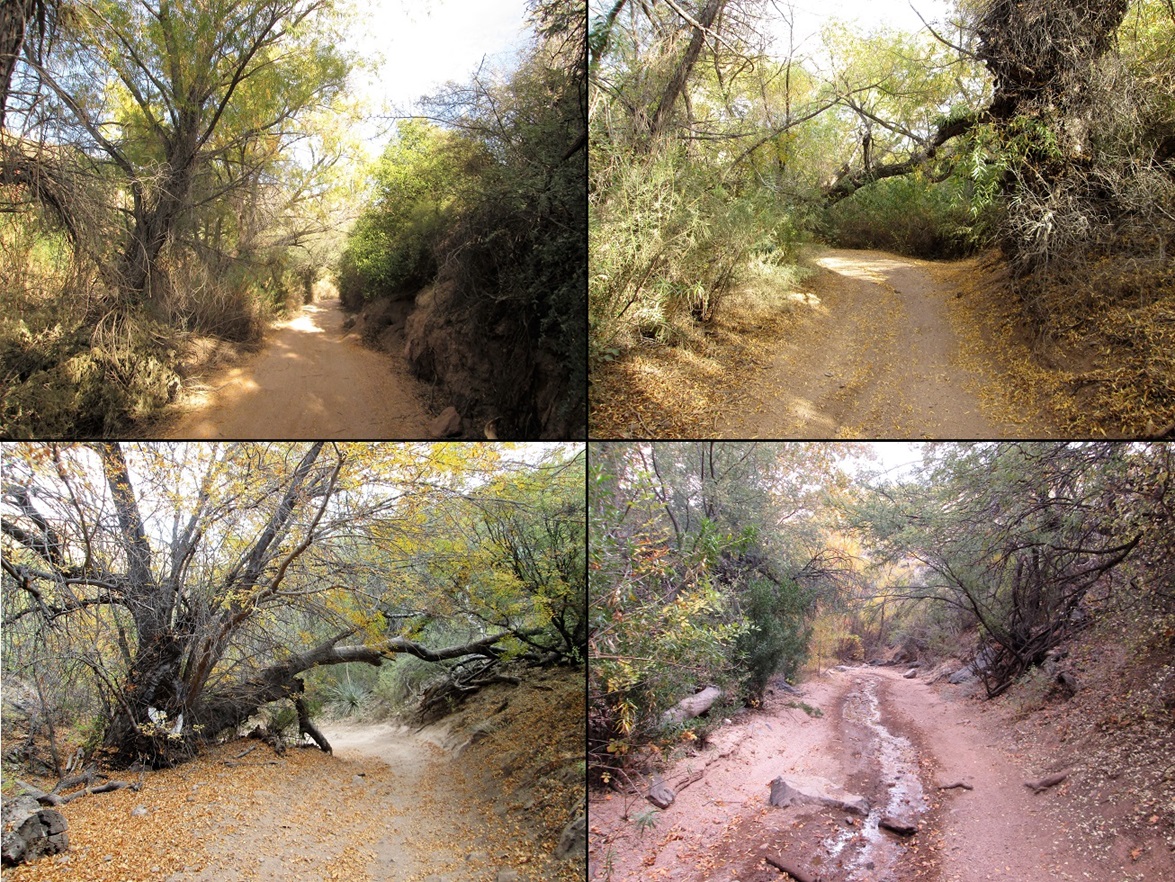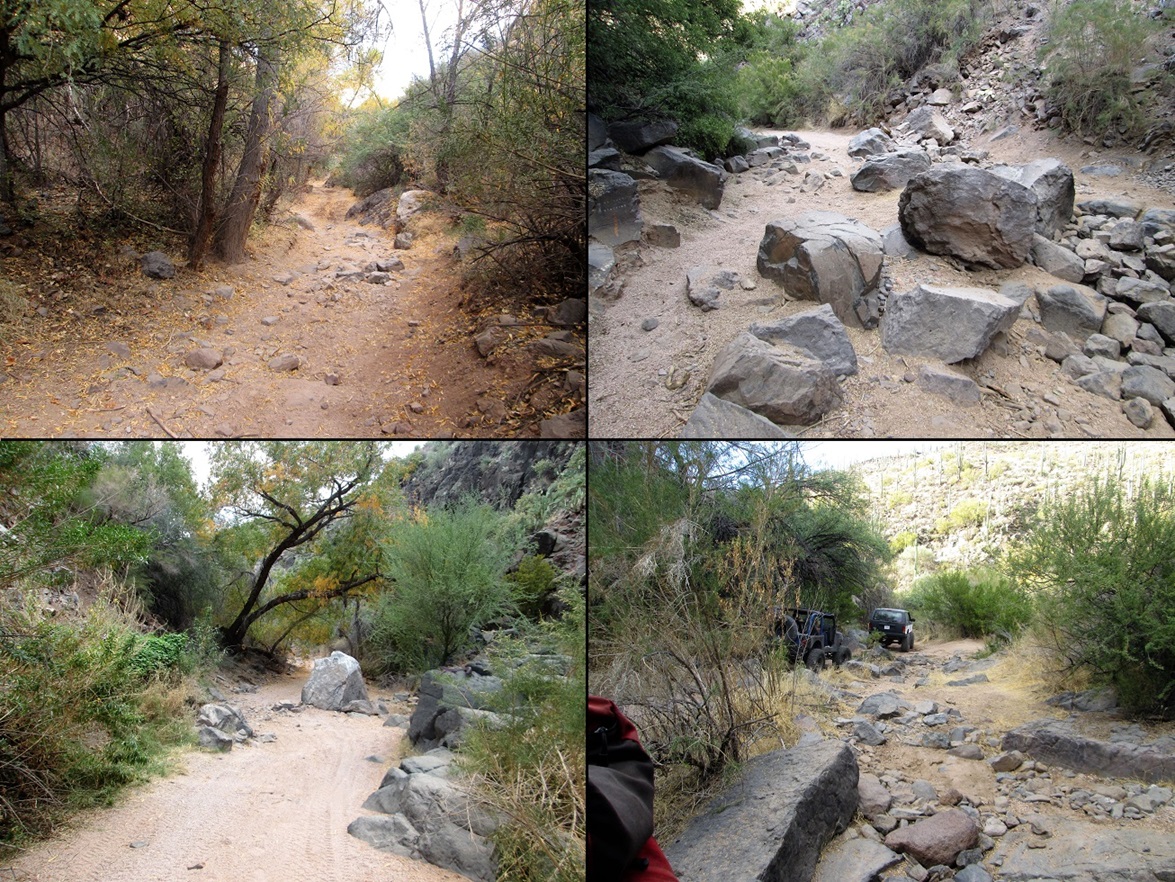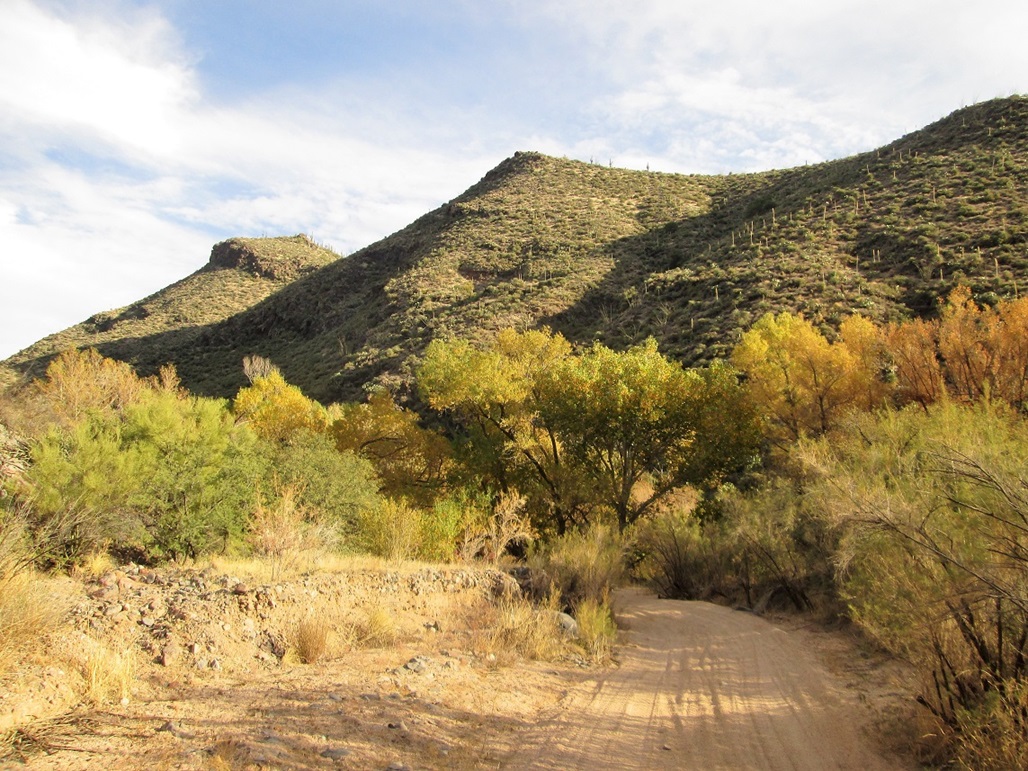
The Mountains of Arizona
• www.surgent.net
|
| Granite Mountain • Otero Benchmark |
• Mazatzal Mountains • Tonto National Forest • Maricopa County |
|
Date: December 2, 2017
• Elevation: 4,699 feet
• Prominence: 1,059 feet
• Distance: 10 miles
• Time: 8 hours
• Gain: 2,400 feet
• Conditions: Overcast at first, then sunny later, warm toward the end
• Teammate: Mattias Stender
Arizona
•
Main
•
AZ P1K
Ambiguity Alert: There are many mountains named Granite in Arizona. Others I have climbed are Granite Mountain in Scottsdale, Granite Mountain near Superior, and Granite Mountain near Prescott.
Granite Mountain rises southeast of Bartlett Lake, a "foothill" of the Mazatzal Mountains, but with over one-thousand feet of prominence. The Beeline Highway (AZ-87) runs east of the mountain and is the most logical way to access the peak, which sits about four miles west of the highway. A sandy "forest" road called Log Corral Canyon Road aims west toward the peak before descending down the other side toward Bartlett Dam.
Scott Peavy and I were here in January of this year, intending to hike the peak. We were here a day or two after a fairly big winter rain storm, in which snow levels dropped to about 4,000 feet. When we arrived at the Sycamore Creek parking and staging area off of the Beeline, it was cold and damp. The first segment of the hike is a sandy road that runs alongside and within Sycamore Creek. Unfortunately, the creek was raging with water. We got about a half mile and could go no farther. The water was flowing fast, it was deep and probably a degree above freezing. Even the mud alongside the creek was so damp that it became almost quicksand-like. After a couple tries to bypass the swollen creek, we wisely backed off and went to hike some other peaks to salvage the day.
Mattias and I came back to give it another try this weekend. I drove us to the trailhead, which has a lot of open space to park since the vast majority of visitors here are 4-wheel drive people with their trucks and haulers. We arrived at 7:30 a.m., the second car here, quiet for now. We got geared up and were walking at 7:45, the day cool and overcast.
We followed the road along Sycamore Creek for about three-quarters of a mile, losing about 40 feet. In a glade of big cottonwoods, the road makes a hard right, now labeled Tonto National Forest Road 3456, the Log Corral Canyon Road. This road snakes up through a tight side canyon (Log Corral Canyon). For the next mile or so, it's a narrow canyon, the walls sometimes right alongside the road. Some sections were covered in giant rocks, showstoppers for just about any 4-wheel drive vehicle with less than 2 feet of clearance. I couldn't fathom how people would get past some of these sections, but there were fresh tracks, so they obviously do.
For about 500 feet within this narrow section, we walked along a small rivulet of water which ran within the road, emanating from the Log Corral Spring. The trees were dense and healthy here, tapping into that spring water. In places, they formed a canopy above the road. It was all very lovely.
In time, the canyon widened and the road now straightened out, trending properly west now. Granite Mountain was visible up ahead, still a couple miles away. The day was heavily overcast and cool, but not cold, perhaps in the mid 60s. We walked the road, which had a steady uphill gradient which was never too steep, but often sandy so that walking it took more effort. Although still on forest land, there were no trees here, just nice mid-elevation desert scrub and saguaro cactus.
We walked to a point north of the peak where the road makes a hard-right bend, elevation just shy of 3,400 feet. This was about 4 miles from the car, and had taken us just under 2 hours. Although pitched at a generally pleasant grade, we had gained over a thousand feet in elevation since starting. We were now directly north of the peak, intending to follow its long north ridge that we had been eyeballing the whole hike in. So we took a break, then started in.
We followed a drainage a brief ways, then bailed left and got onto this ridge, which was easy at first. It was mostly open with plentiful lanes through the brush. We hiked from rock outcrop to rock outcrop. We quickly gained about 300 feet, putting us at the base of a much steeper slope.
Here, the brush closed in a little more, but we were still able to (mostly) weave through it by finding lanes, sometimes needing to move far to one side to find these openings. This segment gained another 500 feet, and we took another break on a neat rocky platform with good views of the surrounding ridges and peaks. We could see the summit poking above a closer ridge, about 0.3 mile away, but still another 500 feet up.
We walked up an easy grade to top out on a small knob, where we had unobstructed views of the top and its rocky protrusions. If we stayed on the ridge proper, we would be encountering about three more rock outcrops. Instead, we angled right (west) and looked for slopes that should get to the top without too much thinking. It all looked equally brushy.
That final 400 vertical feet was nasty. Try as we might, we could not find open lanes to travel through. We often had to barge directly through the thick, woody, tangly brush. It was very slow going, not to mention scratchy. Finally, we were just below the top and out of the nastiest of the brush. We arrived onto the summit at 11:45, a four-hour oneway ascent. The segment from the road to here had taken us over two hours.
The summit features about four rock pillars and other rock slabs lying in a heap. The highest pillar was the easternmost one, about 15 feet tall. The one next to it was about 2 feet lower, and held the benchmark (called "Otero" says the maps, but not stamped with any name here). This pillar was easy to ascend, so we did, one at a time.
That 15-footer was trouble. It has a big crack on its west side, in which rocks and branches have been stuffed into it as ad-hoc hand- and foot-holds. Neither of us felt comfortable scampering up the crack to the top. When I stuck my foot in it, it got stuck! It had to wiggle it out carefully. Had I had weight on it, I'd likely have a broken ankle right now. It was an awkward crack to say the least. There were no better options from other angles.
Thus, we were unable to tag the highest point. We found a large branch and took turns tagging it vicariously, then got our victory photos on the lower pillar. To be within a couple feet of it and foiled was frustrating, but it would have been foolish for us to chance an injury on it.
The upside was that the overcast skies started to open up and become more sunny. We now had excellent lighting for photos. We took about a 45-minute rest up top, picking out all the peak we've climbed that we could see. Me, I could see Diamond, Ord, Four Peaks, Pine, Union, West Cedar, Humboldt, Quien Sabe, Butte, Granite (Scottsdale Preserve), Brown's Ranch, Thompson, McDowell, East End, Sunrise, White Tank, Sierra Estrella, Santan, Pass, Dome, Superstition, Iron Dike and Mazatzal.
We did not look forward to the hike down, but we had no choice. We were able to use gravity to plow through the brush, and lower down, eyeball possible openings in the brush better. But it was slow and scratchy, not much better or faster than going up. It was a relief to be down to the road again. With sunnier skies, we took more photos. All those seen here were taken as we hiked out.
The exciting thing about the road is that occasionally, we'd hear loud buzzing, so we'd step aside as some dirtbikers or polaris-riders would come flying past us. The road is narrow in spots with some blind turns so had we not stepped aside, they would never have stopped in time for us. When we were in the narrow section, we could hear and see some vehicles doing battle with those rocks you see in the images here. They had the right set-up for these rocks, with huge clearance and big tires. They were taking those rocks very slowly, but they got past them. I was impressed.
We were soon back out to the Sycamore Creek segment, and then back to my car, arriving just before 4 p.m., an 8-hour hike covering about 10 miles round trip. It had been a good hike, but brushier than I had expected. These peaks in the lower Mazatzals are known for being brushy, so I don't know why I was surprised. I drove us into town and we parted ways, again happy to have another successful hike in the books with no injuries.
|
|
